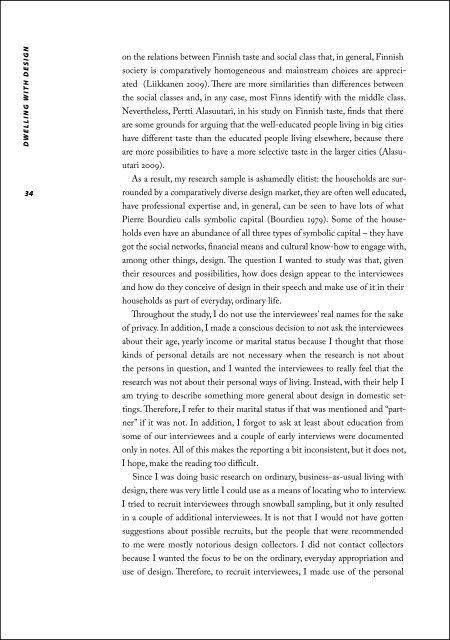Lataa ilmaiseksi
Lataa ilmaiseksi
Lataa ilmaiseksi
Create successful ePaper yourself
Turn your PDF publications into a flip-book with our unique Google optimized e-Paper software.
D W E L L I N G W I T H D E S I G N<br />
34<br />
on the relations between Finnish taste and social class that, in general, Finnish<br />
society is comparatively homogeneous and mainstream choices are appreciated<br />
(Liikkanen 2009). There are more similarities than differences between<br />
the social classes and, in any case, most Finns identify with the middle class.<br />
Nevertheless, Pertti Alasuutari, in his study on Finnish taste, finds that there<br />
are some grounds for arguing that the well-educated people living in big cities<br />
have different taste than the educated people living elsewhere, because there<br />
are more possibilities to have a more selective taste in the larger cities (Alasuutari<br />
2009).<br />
As a result, my research sample is ashamedly elitist: the households are surrounded<br />
by a comparatively diverse design market, they are often well educated,<br />
have professional expertise and, in general, can be seen to have lots of what<br />
Pierre Bourdieu calls symbolic capital (Bourdieu 1979). Some of the households<br />
even have an abundance of all three types of symbolic capital – they have<br />
got the social networks, financial means and cultural know-how to engage with,<br />
among other things, design. The question I wanted to study was that, given<br />
their resources and possibilities, how does design appear to the interviewees<br />
and how do they conceive of design in their speech and make use of it in their<br />
households as part of everyday, ordinary life.<br />
Throughout the study, I do not use the interviewees’ real names for the sake<br />
of privacy. In addition, I made a conscious decision to not ask the interviewees<br />
about their age, yearly income or marital status because I thought that those<br />
kinds of personal details are not necessary when the research is not about<br />
the persons in question, and I wanted the interviewees to really feel that the<br />
research was not about their personal ways of living. Instead, with their help I<br />
am trying to describe something more general about design in domestic settings.<br />
Therefore, I refer to their marital status if that was mentioned and “partner”<br />
if it was not. In addition, I forgot to ask at least about education from<br />
some of our interviewees and a couple of early interviews were documented<br />
only in notes. All of this makes the reporting a bit inconsistent, but it does not,<br />
I hope, make the reading too difficult.<br />
Since I was doing basic research on ordinary, business-as-usual living with<br />
design, there was very little I could use as a means of locating who to interview.<br />
I tried to recruit interviewees through snowball sampling, but it only resulted<br />
in a couple of additional interviewees. It is not that I would not have gotten<br />
suggestions about possible recruits, but the people that were recommended<br />
to me were mostly notorious design collectors. I did not contact collectors<br />
because I wanted the focus to be on the ordinary, everyday appropriation and<br />
use of design. Therefore, to recruit interviewees, I made use of the personal
















